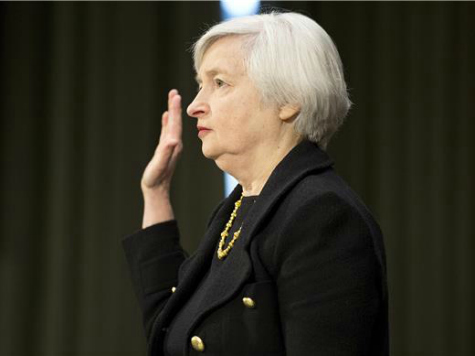
The U.S. Federal Reserve released minutes of its Open Market Committee (FOMC) meeting for July 29th and 30th Wednesday. The tone of the meeting showed a higher level of concern among the members that the Fed’s stimulus coupled with an increasingly stronger economy threatens to unleash inflation. Economists immediately interpreted this as the Fed getting more “hawkish” and meaning it may move sooner next year to begin raising interest rates. Traders sold bonds, driving up yields on the ten-year U.S. Treasury bond that influences mortgage rates to 2.43%, up from Friday’s 2.31% low. Ever since Janet Yellen was nominated as Chairwoman, the U.S. economy and employment has benefited as the Federal Reserve moves to abandon Keynesianism.
Most Committee members agreed that labor market conditions have “improved more in recent months than they had anticipated earlier.” Several members expressed concern that the “characterization of labor market underutilization might have to change before long, particularly if progress in the labor market continued to be faster than anticipated.”
With the conditions moving “noticeably closer to those viewed as normal in the longer run,” the July FOMC statement shifted attention from the unemployment rate to focusing on the broader labor market indicators. Staff also revised down its estimate of potential GDP growth, referred to as the output gap, in light of the continued outperformance of labor market indicators.
The housing recovery was described as “slow” and was not helped by record levels of student debt and the return of high home prices that has made access to credit difficult for first-time home buyers. Some members seemed to feel that “factors restraining residential construction might persist, damping the housing recovery for some time.”
There also were new concerns expressed that securities markets were getting frothy. There is some evidence of stretched valuations, but most members seemed to feel that this was more about some sectors rather than markets in general. With the deleveraging of the bank system and restrictions on lending from Dodd-Frank, members agreed that “vulnerabilities in the financial system were at low-to-moderate levels.”
All of this is consistent with my belief that the Federal Reserve under Chairwoman Janet Yellen is moving rapidly to get out of the Keynesianism discretionary stimulus business and get back to the following what is referred to as the Taylor Rule to set interest rate policy.
The Taylor Rule is a quantitative algorithm that sets the Fed’s nominal interest rate in response to changes in inflation, output, or other economic conditions. The Taylor Principal stipulates that for every one-percent increase in inflation, the Fed should raise the nominal interest rate by more than one percentage point to take the steam out of inflation. As inflation falls one percent, the Fed should also cut rates faster than one percent.
From 1985 to 2007, the Fed’s following the Taylor Rule led to the “Great Moderation,” a period of consistent growth with low volatility for gross domestic product growth, industrial production, and monthly payroll employment.
Following the Lehman Brothers bankruptcy in September 2008, the Taylor Rule was abandoned by the Obama administration and the Federal Reserve under Chairman Bernanke for a policy of massive Keynesian economic stimulus that ran up of $7 trillion in debt, while America suffered the weakest economic recovery in history.
To supposedly encourage stimulus, the Federal Reserve instituted a policy to lend money to banks at a cheaper interest rate than banks were charging in the free market. But at the same time, the Obama administration passed legislation that raised bank costs and discouraged lending to small business. I believe this explains why the richest 1% of Americans and multi-national corporations have prospered, while most Americans have seen only ½% of real wage gains. Instead of money flowing to small business ad households, the 1% were able borrow money at unbelievably low rates and speculate in stocks, bonds, and rental properties.
The Federal Reserve staff presented what was referred to as a “possible approach” that seemed to be positively received by the Committee members and that would raise interest rates “some time in the future” in 1/4 percent increments based on a complicated formula that really just means the interest rates that banks set in the free market to loan and borrow money from each other. There was also general consensus on the Committee that the Fed should make the interest rate on money they offer to lend to the banks be more expensive than the free market to discourage borrowing from the Fed.
On October 9, 2013, Janet Yellen was officially nominated to replace Ben Bernanke as head of the Federal Reserve. During the nomination hearings held on November 14, 2013, Yellen testified that U.S. monetary policy is to revert towards more traditional monetary policy once the economy is back to normal.
Since the government shutdown and Yellen’s nomination, it has been as if the starter gun went off for American small business to start expanding and hiring. With energy prices falling as domestic oil and gas booms, America seems positioned for the type of growth that will drive wages for American workers again.
Chriss Street will respond to readers’ comments.

COMMENTS
Please let us know if you're having issues with commenting.